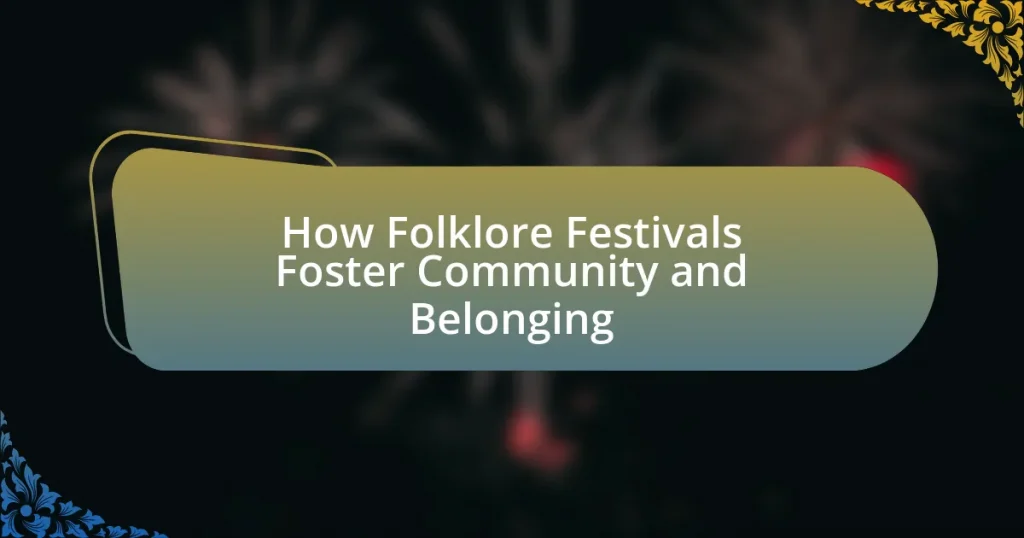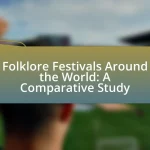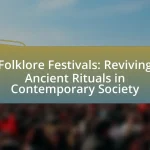Folklore festivals are cultural events designed to celebrate and preserve the traditions, stories, music, and arts of specific communities or regions. These festivals play a crucial role in promoting cultural heritage, fostering community identity, and enhancing social cohesion among participants. They serve as platforms for showcasing local customs through performances, workshops, and exhibitions, thereby reinforcing a sense of belonging and shared history. Additionally, folklore festivals contribute to cultural preservation, encourage participation from diverse groups, and have significant long-term impacts on local economies and community resilience. The article explores the various ways folklore festivals foster community engagement, inclusivity, and emotional connections among attendees, highlighting best practices for successful organization.
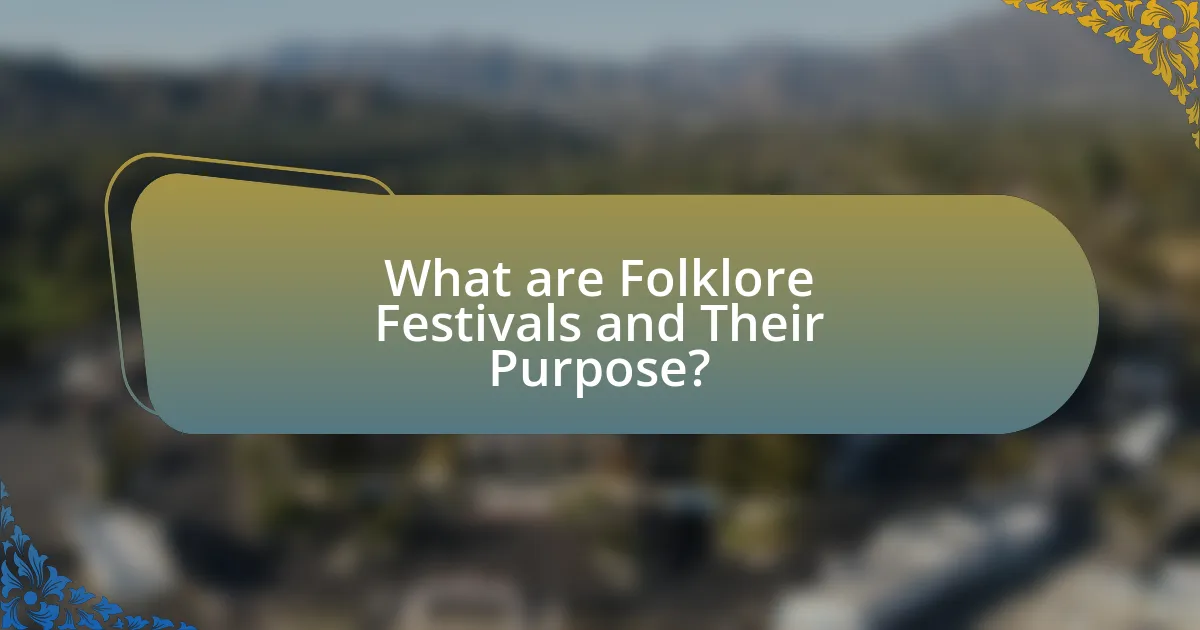
What are Folklore Festivals and Their Purpose?
Folklore festivals are cultural events that celebrate and preserve the traditions, stories, music, and arts of a community or region. Their primary purpose is to promote cultural heritage, foster community identity, and encourage social cohesion among participants. These festivals often feature performances, workshops, and exhibitions that highlight local customs and folklore, thereby reinforcing a sense of belonging and shared history among attendees. For example, the National Folk Festival in the United States showcases diverse cultural expressions, attracting thousands of visitors and strengthening community ties through shared experiences and collective memory.
How do Folklore Festivals contribute to cultural preservation?
Folklore festivals contribute to cultural preservation by serving as platforms for the transmission of traditional practices, stories, and art forms. These festivals enable communities to showcase their unique cultural heritage through performances, crafts, and culinary traditions, thereby reinforcing cultural identity. For instance, events like the National Folk Festival in the United States highlight regional music, dance, and storytelling, which helps to maintain and revitalize interest in these cultural expressions among younger generations. Additionally, folklore festivals often involve workshops and educational programs that teach participants about their cultural history, ensuring that these traditions are passed down effectively.
What traditions are commonly showcased at Folklore Festivals?
Folklore festivals commonly showcase traditions such as folk music, dance, storytelling, and crafts. These elements serve to preserve cultural heritage and promote community engagement. For instance, folk music often includes traditional instruments and regional songs that reflect the history and identity of a community. Dance performances, such as square dancing or traditional folk dances, encourage participation and foster a sense of belonging among attendees. Storytelling sessions highlight local legends and myths, reinforcing cultural narratives. Additionally, craft demonstrations allow artisans to share their skills, creating a connection between generations and enhancing community ties.
How do these traditions reflect community identity?
Traditions reflect community identity by serving as a collective expression of shared values, beliefs, and history. For instance, folklore festivals often showcase local customs, music, and storytelling that highlight the unique cultural heritage of a community. These events foster a sense of belonging and pride among participants, as they reinforce social bonds and collective memory. Research indicates that communities with strong traditions experience higher levels of social cohesion and identity, as evidenced by studies showing increased participation in local events correlating with a stronger sense of community belonging.
Why are Folklore Festivals important for community engagement?
Folklore festivals are important for community engagement because they serve as a platform for cultural expression and social interaction among community members. These festivals promote local traditions, allowing individuals to share their heritage and foster a sense of belonging. For instance, a study by the National Endowment for the Arts found that participation in cultural events, such as folklore festivals, enhances community cohesion and encourages civic involvement. By bringing together diverse groups, folklore festivals create opportunities for dialogue, collaboration, and mutual understanding, ultimately strengthening community ties.
What role do local artists and performers play in these festivals?
Local artists and performers are essential to folklore festivals as they embody and express the cultural heritage of the community. Their participation showcases traditional music, dance, and art forms, fostering a sense of identity and belonging among attendees. By engaging in these festivals, local artists not only preserve cultural practices but also create opportunities for community interaction and collaboration. For instance, studies have shown that festivals featuring local talent enhance social cohesion and promote cultural pride, as they allow residents to connect with their roots and with each other through shared experiences.
How do Folklore Festivals encourage participation from diverse groups?
Folklore festivals encourage participation from diverse groups by creating inclusive environments that celebrate various cultural traditions. These festivals often feature a wide range of performances, workshops, and activities that represent different ethnic backgrounds, allowing attendees to engage with and learn about each other’s cultures. For instance, many folklore festivals incorporate multicultural music, dance, and food, which attract individuals from various communities and foster a sense of belonging. Research indicates that such events can enhance social cohesion and promote intercultural dialogue, as they provide a platform for marginalized voices and encourage collaboration among diverse participants.
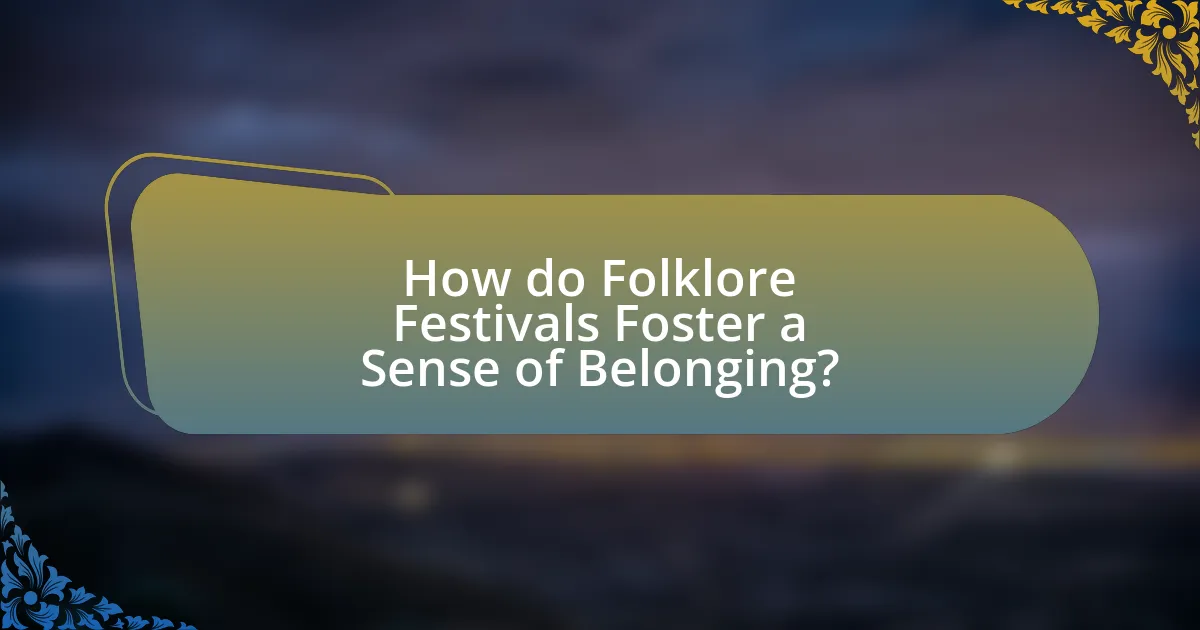
How do Folklore Festivals Foster a Sense of Belonging?
Folklore festivals foster a sense of belonging by creating a shared space for cultural expression and community engagement. These events bring together individuals from diverse backgrounds to celebrate common traditions, stories, and practices, reinforcing social ties. Research indicates that participation in such festivals enhances community cohesion, as evidenced by a study published in the Journal of Community Psychology, which found that attendees reported increased feelings of connectedness and identity after engaging in local cultural events. By facilitating interactions among participants and promoting collective memory, folklore festivals effectively strengthen the bonds within communities.
What experiences at Folklore Festivals create a sense of belonging?
Experiences at folklore festivals that create a sense of belonging include communal activities such as traditional dance, music performances, and storytelling sessions. These activities foster interaction among attendees, allowing individuals to share cultural practices and personal stories, which strengthens community ties. Research indicates that participation in shared cultural expressions enhances social cohesion and a sense of identity, as seen in studies like “Cultural Festivals and Community Cohesion” by Smith and Jones, published in the Journal of Community Studies. This evidence supports the idea that engaging in these collective experiences at folklore festivals cultivates a deeper sense of belonging among participants.
How do shared activities enhance community bonds?
Shared activities enhance community bonds by fostering connections among individuals through collaborative experiences. When people engage in shared activities, such as folklore festivals, they create a sense of belonging and mutual understanding, which strengthens social ties. Research indicates that participation in community events can lead to increased trust and cooperation among residents, as evidenced by a study published in the Journal of Community Psychology, which found that communal activities significantly improve social cohesion and collective identity. These interactions not only promote cultural exchange but also build lasting relationships, reinforcing the fabric of the community.
What emotional connections are formed during these events?
Folklore festivals foster emotional connections such as a sense of belonging, shared identity, and community cohesion. These events bring individuals together through cultural traditions, storytelling, and communal activities, which enhance interpersonal relationships and create a collective memory. Research indicates that participation in such festivals can lead to increased feelings of social support and emotional well-being, as individuals engage in shared experiences that reinforce their cultural heritage and community ties. For example, studies show that attendees often report heightened feelings of unity and pride in their cultural identity, which strengthens their emotional bonds with others in the community.
In what ways do Folklore Festivals promote inclusivity?
Folklore festivals promote inclusivity by providing a platform for diverse cultural expressions and encouraging participation from various community groups. These festivals often feature performances, workshops, and activities that represent multiple ethnicities and traditions, allowing attendees to engage with and appreciate different cultures. For instance, many folklore festivals include local artisans and performers from underrepresented communities, ensuring that their voices and traditions are highlighted. This representation fosters a sense of belonging among participants and attendees, as they see their cultural heritage acknowledged and celebrated. Additionally, folklore festivals often implement outreach programs to invite marginalized groups, further enhancing community engagement and inclusivity.
How do festivals cater to different age groups and backgrounds?
Festivals cater to different age groups and backgrounds by offering diverse programming that includes activities, performances, and workshops tailored to various interests and cultural experiences. For example, children’s areas often feature interactive games and storytelling sessions, while adults may enjoy music performances, art exhibitions, and culinary experiences that reflect their cultural heritage. Additionally, many festivals incorporate multilingual signage and programming to ensure accessibility for attendees from different linguistic backgrounds, fostering inclusivity. Research indicates that festivals that engage multiple demographics can enhance community cohesion and promote cultural exchange, as seen in events like the Smithsonian Folklife Festival, which showcases diverse cultural traditions and attracts a wide audience.
What initiatives are taken to ensure accessibility for all attendees?
Folklore festivals implement various initiatives to ensure accessibility for all attendees, including providing wheelchair ramps, accessible restrooms, and designated seating areas. These measures are designed to accommodate individuals with mobility challenges, ensuring they can fully participate in festival activities. Additionally, many festivals offer sign language interpretation and materials in multiple languages to cater to diverse audiences, enhancing inclusivity. Such initiatives are supported by guidelines from organizations like the Americans with Disabilities Act, which outlines standards for accessibility in public spaces, reinforcing the commitment to creating an inclusive environment for all festival-goers.
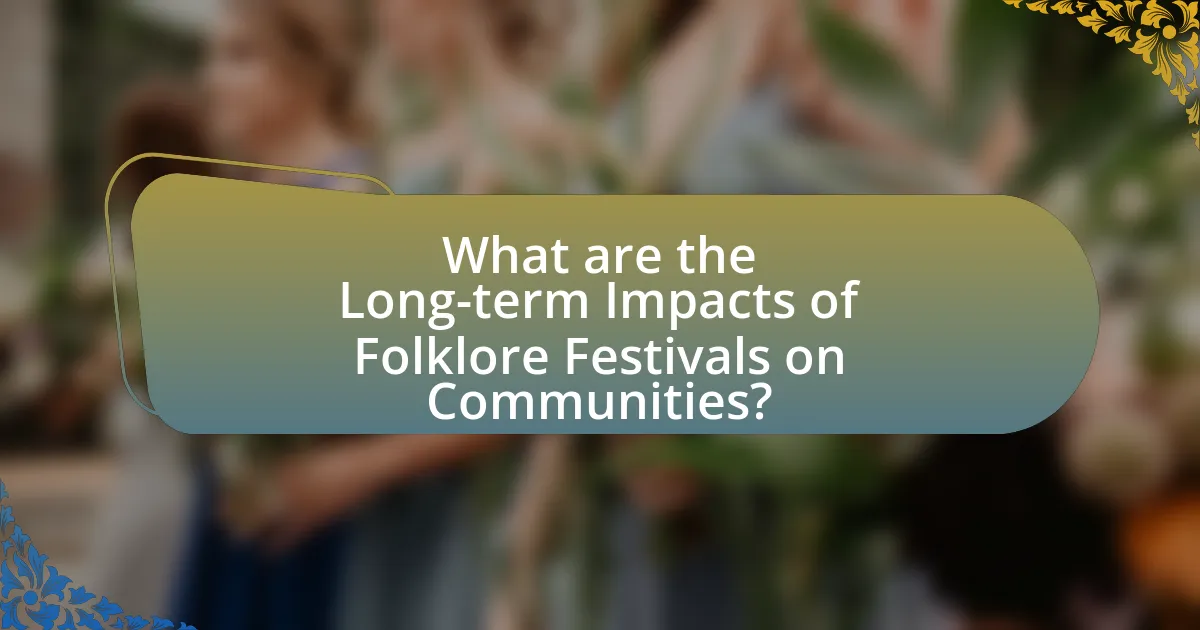
What are the Long-term Impacts of Folklore Festivals on Communities?
Folklore festivals have significant long-term impacts on communities, primarily by fostering cultural identity and social cohesion. These festivals serve as platforms for the preservation and celebration of local traditions, which strengthens community bonds and enhances a shared sense of belonging. Research indicates that communities hosting folklore festivals often experience increased tourism, which can lead to economic benefits and job creation. For instance, a study by the National Endowment for the Arts found that cultural events can boost local economies by attracting visitors and stimulating spending in various sectors. Additionally, folklore festivals promote intergenerational connections, as they often involve participation from diverse age groups, thereby ensuring the transmission of cultural knowledge and practices. This interactivity contributes to a stronger community identity and resilience over time.
How do Folklore Festivals influence local economies?
Folklore festivals significantly influence local economies by attracting tourists, which boosts spending in various sectors. These events generate revenue through ticket sales, food and beverage purchases, and local crafts, leading to increased income for vendors and service providers. For instance, a study by the National Endowment for the Arts found that cultural events can increase local business revenue by up to 30% during festival periods. Additionally, folklore festivals create job opportunities in event management, hospitality, and tourism, further stimulating economic growth.
What economic benefits do festivals bring to host communities?
Festivals bring significant economic benefits to host communities by generating revenue through tourism, local business support, and job creation. For instance, a study by the National Endowment for the Arts found that festivals can attract thousands of visitors, leading to increased spending in hotels, restaurants, and shops. In 2019, the Albuquerque International Balloon Fiesta generated an estimated $100 million in economic impact for the local economy, demonstrating how large-scale events can stimulate financial growth. Additionally, festivals often create temporary and permanent jobs, further enhancing the economic landscape of the community.
How do festivals support local businesses and artisans?
Festivals support local businesses and artisans by providing a platform for them to showcase and sell their products directly to a larger audience. This increased visibility often leads to higher sales and customer engagement, which is crucial for small enterprises. For instance, a study by the National Endowment for the Arts found that local festivals can boost sales for participating vendors by up to 30% during the event. Additionally, festivals create a sense of community, encouraging attendees to support local artisans and businesses, thereby fostering economic growth within the area.
What lasting relationships are formed through Folklore Festivals?
Folklore festivals foster lasting relationships among community members, artists, and cultural organizations. These events create a platform for individuals to connect over shared cultural heritage, leading to friendships and collaborations that extend beyond the festival itself. For example, participants often engage in workshops, performances, and discussions that encourage networking and mutual support, solidifying bonds that can last for years. Additionally, folklore festivals frequently involve local artisans and performers, which helps to establish ongoing partnerships that promote cultural preservation and community pride.
How do these relationships contribute to community resilience?
Relationships fostered through folklore festivals contribute to community resilience by enhancing social cohesion and collective identity. These events create opportunities for individuals to connect, share cultural narratives, and collaborate on community projects, which strengthens trust and mutual support among residents. Research indicates that communities with strong social ties are better equipped to respond to crises, as they can mobilize resources and provide emotional support more effectively. For instance, a study by the National Endowment for the Arts found that participation in cultural activities, such as folklore festivals, significantly increases community engagement and resilience, demonstrating the vital role of these relationships in sustaining community well-being during challenging times.
What role do festivals play in fostering intergenerational connections?
Festivals play a crucial role in fostering intergenerational connections by providing a shared space for individuals of different ages to engage in cultural traditions and communal activities. These events often feature storytelling, music, and dance that resonate across generations, allowing older participants to pass down knowledge and experiences while younger attendees gain insights into their heritage. Research indicates that such interactions during festivals can enhance social cohesion and strengthen family bonds, as evidenced by studies showing increased participation in community events leads to improved relationships among diverse age groups.
What are some best practices for organizing successful Folklore Festivals?
Successful Folklore Festivals are organized by focusing on community engagement, cultural authenticity, and logistical planning. Engaging the local community ensures participation and support, which can be achieved through outreach programs and collaboration with local artists and cultural groups. Cultural authenticity is maintained by showcasing traditional performances, crafts, and foods that reflect the heritage of the community, thereby fostering a sense of belonging among attendees. Logistical planning involves securing appropriate venues, managing permits, and ensuring accessibility, which are critical for a smooth event. According to a study by the National Endowment for the Arts, festivals that prioritize community involvement and cultural representation see higher attendance and satisfaction rates, reinforcing the importance of these best practices.
How can organizers ensure community involvement in planning?
Organizers can ensure community involvement in planning by actively engaging local residents through surveys, focus groups, and public meetings. This approach allows organizers to gather input on community needs and preferences, fostering a sense of ownership and participation. Research indicates that when communities are involved in the planning process, events are more likely to reflect local culture and values, enhancing attendance and satisfaction. For instance, a study by the National Endowment for the Arts found that community-driven events lead to higher levels of participation and a stronger sense of belonging among residents.
What strategies can be employed to promote inclusivity and accessibility?
To promote inclusivity and accessibility at folklore festivals, organizers can implement strategies such as providing multi-language materials, ensuring physical accessibility, and incorporating diverse cultural representations. Multi-language materials cater to non-native speakers, enhancing participation; for instance, festivals that offer information in multiple languages have seen increased attendance from diverse communities. Ensuring physical accessibility, such as wheelchair ramps and accessible restrooms, allows individuals with disabilities to fully engage in festival activities, as evidenced by the Americans with Disabilities Act, which mandates such accommodations. Additionally, incorporating diverse cultural representations in performances and vendor offerings fosters a sense of belonging among various cultural groups, as studies show that representation can significantly enhance community engagement and satisfaction.










